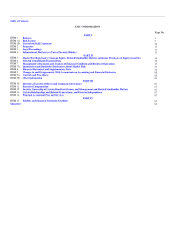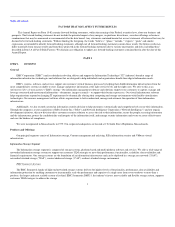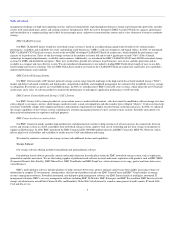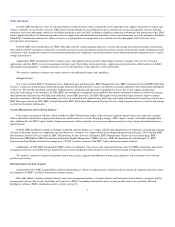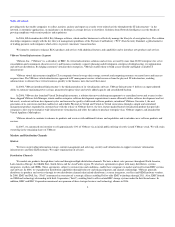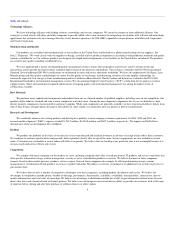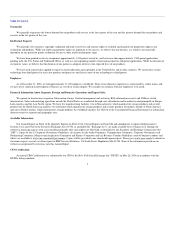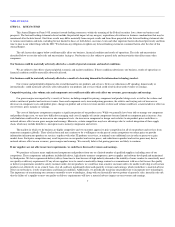EMC 2006 Annual Report Download - page 14
Download and view the complete annual report
Please find page 14 of the 2006 EMC annual report below. You can navigate through the pages in the report by either clicking on the pages listed below, or by using the keyword search tool below to find specific information within the annual report.
Table of Contents
Changes in generally accepted accounting principles may adversely affect us.
From time to time, the Financial Accounting Standards Board ("FASB") promulgates new accounting principles that are applicable to us. In the first
quarter of 2006, we adopted Financial Accounting Standard ("FAS") FAS No. 123R "Share-based Payment" ("FAS No. 123R"). This standard requires us to
expense the fair value of stock options issued to employees in our basic financial statements. This has adversely affected our results of operations. The FASB
has proposed or promulgated other standards, including modifying the accounting for income taxes, accounting for business combinations and fair value
measurements. These proposed and new standards or other proposals could have a material adverse impact on our results of operations or financial condition.
The Financial Accounting Standards Board's Emerging Issues Task Force (the "Task Force") has on its agenda a plan to review the accounting for
convertible debt instruments that require or permit partial cash settlement upon conversion. The Task Force has proposed to discuss whether the current
accounting treatment should be retained or if it should be modified to require the debt portion to be recorded at the fair market value of a similar liability. If
the Task Force concludes that the accounting should be modified, this would result in incremental interest expense being recognized on our convertible debt
instrument over the life of the debt, negatively impacting our diluted earnings per share.
Our quarterly revenues and earnings could be materially adversely affected by uneven sales patterns and changing purchasing behaviors.
Our quarterly sales have historically reflected an uneven pattern in which a disproportionate percentage of a quarter's total sales occur in the last month
and weeks and days of each quarter. This pattern makes prediction of revenues, earnings and working capital for each financial period especially difficult and
uncertain and increases the risk of unanticipated variations in quarterly results and financial condition. We believe this uneven sales pattern is a result of many
factors including:
• the relative dollar amount of our product and services offerings in relation to many of our customers' budgets, resulting in long lead times for
customers' budgetary approval, which tends to be given late in a quarter
• the tendency of customers to wait until late in a quarter to commit to purchase in the hope of obtaining more favorable pricing from one or more
competitors seeking their business
• the fourth quarter influence of customers' spending their remaining capital budget authorization prior to new budget constraints in the first six
months of the following year
• seasonal influences
Our uneven sales pattern also makes it extremely difficult to predict near-term demand and adjust manufacturing capacity accordingly. If predicted
demand is substantially greater than orders, there will be excess inventory. Alternatively, if orders substantially exceed predicted demand, the ability to
assemble, test and ship orders received in the last weeks and days of each quarter may be limited, which could materially adversely affect quarterly revenues
and earnings.
In addition, our revenues in any quarter are substantially dependent on orders booked and shipped in that quarter and our backlog at any particular time
is not necessarily indicative of future sales levels. This is because:
• we assemble our products on the basis of our forecast of near-term demand and maintain inventory in advance of receipt of firm orders from
customers
• we generally ship products shortly after receipt of the order
• customers may reschedule or cancel orders with little or no penalty
Loss of infrastructure, due to factors such as an information systems failure, loss of public utilities or extreme weather conditions, could impact our
ability to ship products in a timely manner. Delays in product shipping or an unexpected decline in revenues without a corresponding and timely slowdown in
expenses, could intensify the impact of these factors on our business, results of operations and financial condition.
In addition, unanticipated changes in our customers' purchasing behaviors such as customers taking longer to negotiate and complete their purchases or
making smaller, incremental purchases based on their current needs, also make the prediction of revenues, earnings and working capital for each financial
period difficult and uncertain and increase the risk of unanticipated variations in our quarterly results and financial condition.
Risks associated with our distribution channels may materially adversely affect our financial results.
In addition to our direct sales force, we have agreements in place with many distributors, systems integrators, resellers and original equipment
manufacturers to market and sell our products and services. We may, from time to time, derive a significant percentage of our revenues from such distribution
channels. For 2006, Dell Inc., one of our channel partners, accounted for 14.5%
10


